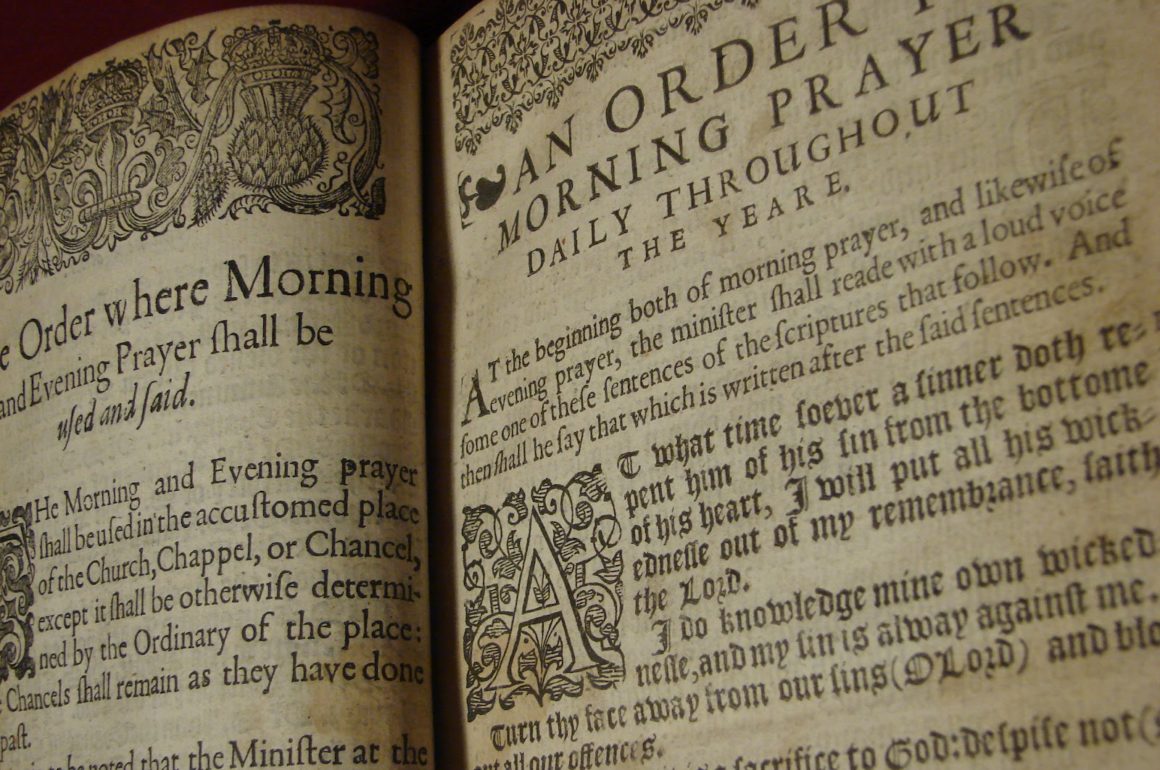How to use the Book of Common Prayer for daily devotions

I wrote recently that the Book of Common Prayer can be used to breathe new life into your daily devotions. Regardless if you’re taking your first steps into a daily prayer habit or you’ve been a faithful prayer warrior for a half-century, this treasury of distilled wisdom can take you deeper into the heart of God and the prayer life of the church than you’ve ever gone before. It has enormously enriched my own prayer life in the several years that I’ve been using it and I hope to share some of what I’ve learned with you here.
The Book of Common Prayer has a rich and complex history that is fascinating in itself, but you don’t have to know very much about it in order to benefit from its guidance in prayer. This article aims at getting you started with praying the daily offices from the Book of Common Prayer, taking a learn-as-you-go approach. As always, we’ll start small.
Where to find the Book of Common Prayer
First, you’ll need to get your hands on the content. If you’re reading this, you have an internet connection and can therefore get free and easy access to the BCP in several different flavors. If you’ve never used written prayers like the BCP before, I recommend starting with these digital resources even if you think you might prefer a bound edition that you can hold in your hands. The reason is that learning to navigate the printed version can be daunting because you have to flip back and forth using the book’s sometimes-confusing print organization. You can always begin with the digital, and if you find it useful, getting a nice printed copy is very affordable online or in your favorite local bookstore. (note: we are able to partially fund our ministry by the very small fees we earn from the above affiliate link. Thanks for supporting us!)
In terms of digital resources, I recommend the use of the Church of England’s Daily Offices web site, which should be highly readable from any computer with a web browser. The web page will attempt to determine the time of day and properly select the morning, evening, or night prayer for the current date. I recommend using the “contemporary” version, which uses modern english. If you regularly use the King James Bible for your daily devotions, the Traditional version may be more to your liking.
If you would prefer an app for smartphones, the same resources from the Church of England are freely accessible for both iPhone and Android.
What exactly is a “daily office”?
The daily orders of prayer and worship outlined in the Book of Common Prayer are called the “daily offices”. The word “office” here is used in a similar sense as the office of president of the United States. While at any given time, the President of the United States is a distinct individual, he or she is also a citizen merely occupying an office larger and more significant than any particular person. To pray the daily office is to step into the priestly role conferred on us by Jesus on the occasion of our baptism. We take up prayers shaped by centuries of accumulated Christian wisdom, rich enough and flexible enough to be instructive and transformative, day in and day out, our whole lives. These prayers preceded us and will continue after we are gone. They are larger than us and we are enlarged by stepping into them.
Pray the Daily Office in pieces
At first glance, the order for each office can appear quite long. Don’t be intimidated by its length; remember that it’s meant to be comprehensive enough to use for public worship. That doesn’t mean you will use every part of it for daily devotions. Most people who use the BCP select parts of it as a general framework and skip over the rest. Let’s go through each section briefly and then you can choose for yourself which of these components you’ll want to use.
Overview of the contents
There are three general orders that make up the Daily Offices: morning prayer, evening prayer, and night prayer. Morning prayer and evening prayer are both longer selections, while night prayer is much shorter and has less variation from day to day. Morning prayer is meant to be used to begin the day, before regular work or leisure begins. Evening prayer is meant for the end of the work day as a kind of pause before we enter into the final stretch of mealtime, rest, and family time that makes up the final third of the day. Night prayer is meant to be used just before retiring for the night.
Throughout the order for prayer, you’ll see notes in the margins indicating which parts are to be read by the leader and which parts are responses on the part of those gathered for prayer. If you’re reading this alone, obviously you’ll be the reader—but let these cues constantly remind you that you are not alone in praying these prayers; God is with you, listening intently, and that others are praying similar prayers around the world on the same day, perhaps even at the very same time.
All the offices have similar organizational structures, broken into four parts:
- Preparation: a series of short “versicles” (short fragments of Scripture) and either an invitational psalm or a seasonal prayer. The preparatory section in the morning and evening ends with a prayer grounding us in the time of day, helping to mark the passing of time and reminding us of God’s presence with us.
- Word of God: after the preparation, we proceed into the first of the two principle parts of the Daily Office. For the longer morning and evening prayer, you’ll find one or more psalms (depending on their length), an Old Testament Reading, and a New Testament reading. The readings are arranged thematically to match certain themes and seasonal events in the life of Jesus, with an overall schedule that covers most of Scripture over time. Sometimes the Old Testament selection is taken from the so-called Deuterocanonical books not considered part of the biblical canon. If you prefer, you can use the alternate canonical readings listed below the non-canonical reading. In between the different selections, you’ll find short transitional prayers such as the “Gloria Patri”, other short “responsory” prayers, and canticles drawn from Scripture and long-standing tradition.
- Prayers: following the selections from the Word of God, there will be directions separate from the actual prayer, guiding you to various themes of intercession and time to be silent before God. Incorporate your own prayers here and use whatever time of silence you think appropriate. Next is the collect of the day, a traditional written prayer calling us to the imitation of holy men and women who have come before us or drawing us into a discipleship theme appropriate to the season. The Lord’s Prayer follows and leads into the concluding section.
- Conclusion: A themed, responsive prayer ends the daily office.
Selecting the components for your daily devotions
If praying written prayers like those in the Book of Common Prayer is new territory for you, I recommend starting small and getting to know the contours of the prayers as you learn to find your own voice in them. Here’s a suggested arrangement of the material for the day.
- New to daily devotions: for those who have never used a written prayer book before and who don’t have a daily devotional habit established. This habit should take 5-7 minutes a day while still putting you in touch with the rhythms of the Christian Year and expose you to a wide range of Bible readings. You’ll use the order for morning prayers only. Here are the components you’ll say:
- In the preparation section, say the opening versicles and the prayer of thanksgiving or invitatory psalm that begins the section. Skip the hymn/song of scripture section and begin again at the “Gloria Patri” that begins with “Glory to the Father and to the Son…”, saying the last few lines over your day.
- Choose one reading in the Word of God section: perhaps sticking from day to day to the New Testament or alternating between New Testament and Psalms.
- In the prayers section, say the collect.
- Say the prayers in the conclusion section.
- As you learn the rhythms of these prayers, consider adding your own requests and intercessory prayers for people in your life before the collect of the day.
- New to the Book of Common Prayer: for those who have a daily devotional habit but want to add some depth, structure, and seasonal rhythm. This habit should take 10-15 minutes a day, putting you deeply in the stream of the Christian Year. You’ll use the order for morning prayers only.
- Say the whole of the preparation section.
- Say the psalm and one of the other readings each day, especially if using the psalms as your own prayer is a new experience for you. Learning to place yourself into the grand narrative of Israel’s prayers as the people of God have been doing for years can be challenging but richly rewarding. Wrestle with the words of psalms that don’t immediately seem to apply; pray them for yourself or as intercessions for others who might have these kinds of prayers in their hearts. Align yourself with God’s steadfast love for his people, accepting it for yourself and praying it into the lives of others. After each reading, say the prayers and responsories following the selections of Scripture, holding in your mind the substance of the Scripture you just read.
- Pray your own prayers and intercessions at the beginning of the prayers section. Then say the collect and the Lord’s prayer. Make the Lord’s Prayer the heart of your daily devotion, moving slowly through each line, recognizing its great breadth and depth, aligning yourself with the words of Jesus and where he is directing your thoughts and prayers through the guidance of each thematic line of the prayer.
- Conclude with the final lines of the office.
- Ready for a new experience of time, ordered by the presence and goodness of God: for those who have been praying the offices for a while and have an established habit of daily devotions, and are now ready for short but powerful patterns of prayer that make holy the hours of each day, offering them to God for his use and glory. You’ll use the morning, evening, and night prayers. Even if you have an established morning prayer routine, adding regular prayers to other parts of your day may still present a challenge. Heed the wisdom of habit change and start small, carving out short spaces of time and expanding them as they become part of your daily routine.
- In the morning, use either an abbreviated or full morning prayer, making your intercessions and giving special attention to the coming few hours before lunchtime.
- At lunch, pause for a moment, reflect over the previous few hours, mark where you’ve noticed his presence with you. Pray the Lord’s Prayer and offer any intercessions or prayers for the coming few hours until dinnertime.
- As you end your work day and begin moving toward the last segment of the day, say an abbreviated selection from the order for evening prayer, with special attention toward the preparatory lines “that this evening may be holy, good, and peaceful”. Let the weight of the day fall from your shoulders as you focus only on what remains of the day.
- Finally, before bed, say the night prayers, allowing God to cleanse your spirit through the prayers of confession, going to your night’s rest in full awareness of his presence, love, and care.
These are only a few suggestions of ways to use the Book of Common Prayer. Listen always to the guidance of the Holy Spirit as you adjust your prayer habits. Allow God himself to lead you into deep, personal knowledge of his love and of the opportunities to bring that love to life in our world. This is the good life of his kingdom.











Leave a Comment